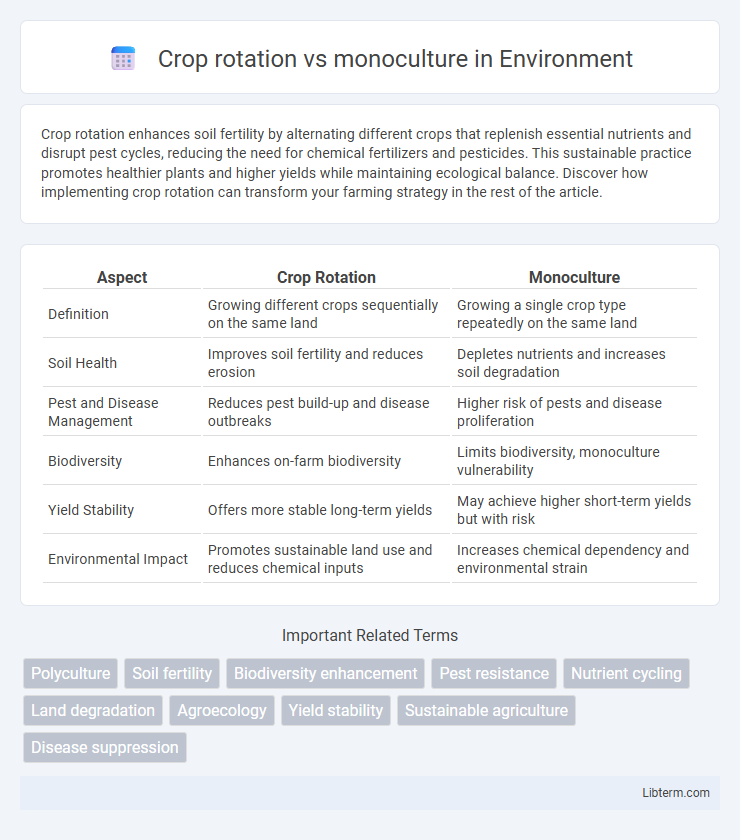Crop rotation enhances soil fertility by alternating different crops that replenish essential nutrients and disrupt pest cycles, reducing the need for chemical fertilizers and pesticides. This sustainable practice promotes healthier plants and higher yields while maintaining ecological balance. Discover how implementing crop rotation can transform your farming strategy in the rest of the article.
Table of Comparison
| Aspect | Crop Rotation | Monoculture |
|---|---|---|
| Definition | Growing different crops sequentially on the same land | Growing a single crop type repeatedly on the same land |
| Soil Health | Improves soil fertility and reduces erosion | Depletes nutrients and increases soil degradation |
| Pest and Disease Management | Reduces pest build-up and disease outbreaks | Higher risk of pests and disease proliferation |
| Biodiversity | Enhances on-farm biodiversity | Limits biodiversity, monoculture vulnerability |
| Yield Stability | Offers more stable long-term yields | May achieve higher short-term yields but with risk |
| Environmental Impact | Promotes sustainable land use and reduces chemical inputs | Increases chemical dependency and environmental strain |
Introduction to Crop Rotation and Monoculture
Crop rotation involves growing different types of crops sequentially on the same land to improve soil health, reduce pests, and enhance yield stability. Monoculture refers to the continuous cultivation of a single crop species in the same area, often leading to soil nutrient depletion and increased vulnerability to diseases. Understanding these farming practices is essential for sustainable agriculture and effective land management.
Historical Overview of Farming Practices
Ancient civilizations practiced crop rotation to maintain soil fertility and reduce pest infestations, with evidence dating back to Roman and Chinese agriculture. Monoculture became widespread during the Industrial Revolution due to mechanization and market demand, despite causing soil depletion and increased vulnerability to diseases. Modern sustainable farming revisits crop rotation techniques to restore ecological balance and improve long-term productivity.
Principles and Methods of Crop Rotation
Crop rotation involves systematically alternating different crops in the same field to improve soil health, reduce pest buildup, and enhance nutrient cycling, while monoculture grows a single crop repeatedly, risking soil depletion and increased pest vulnerability. Key principles of crop rotation include diversifying plant families, optimizing nutrient usage by alternating legumes with heavy feeders, and disrupting pest and disease life cycles. Effective methods often use multi-year plans combining cereals, legumes, and root crops to maintain soil fertility, break pathogen cycles, and improve overall agricultural sustainability.
Understanding Monoculture Systems
Monoculture systems involve cultivating a single crop species continuously on the same land, which can lead to soil nutrient depletion and increased vulnerability to pests and diseases. This agricultural practice tends to reduce biodiversity, impacting soil health and ecosystem stability over time. Understanding the limitations of monoculture highlights the importance of sustainable farming methods such as crop rotation to maintain soil fertility and reduce pest pressures.
Soil Health: Rotation vs Monoculture
Crop rotation enhances soil health by promoting nutrient diversity and reducing pest buildup, leading to improved soil structure and fertility. Monoculture depletes specific nutrients, increases vulnerability to pests, and causes soil degradation over time. Long-term studies show crop rotation supports higher microbial activity and organic matter content compared to continuous monoculture.
Pest and Disease Management in Both Practices
Crop rotation disrupts pest and disease cycles by alternating plant families, reducing host availability and limiting pathogen buildup in soil. Monoculture creates a stable environment for pests and diseases to thrive, often leading to increased pesticide use and resistance development. Integrating diverse crops can enhance natural pest control and soil health, minimizing reliance on chemical interventions.
Crop Yield and Economic Impacts
Crop rotation significantly enhances crop yield by improving soil fertility and reducing pest and disease cycles, leading to more sustainable and higher productivity over time. Monoculture often results in diminished soil nutrients and increased vulnerability to pests, causing yield fluctuations and higher input costs. Economically, crop rotation reduces the need for synthetic fertilizers and pesticides, lowering production expenses and increasing profitability compared to the high risk and potential financial losses associated with monoculture farming systems.
Environmental Sustainability Comparison
Crop rotation enhances environmental sustainability by improving soil fertility, reducing pest and disease cycles, and decreasing the reliance on chemical fertilizers and pesticides. Monoculture farming leads to soil degradation, increased vulnerability to pests, and greater chemical input, which contribute to environmental pollution and biodiversity loss. Sustainable agriculture practices favor crop rotation to maintain ecosystem health and long-term agricultural productivity.
Challenges and Limitations of Each Method
Crop rotation improves soil fertility and reduces pest buildup but requires careful planning and knowledge of crop compatibility to avoid nutrient imbalances. Monoculture offers simplified management and higher short-term yields but leads to soil degradation, increased pest resistance, and vulnerability to diseases. Both methods face challenges: crop rotation's complexity can limit scalability, while monoculture's environmental impacts threaten long-term agricultural sustainability.
Future Trends in Sustainable Agriculture
Crop rotation enhances soil health and biodiversity by alternating plant species, reducing disease risk and improving nutrient cycling, while monoculture often depletes soil nutrients and increases pest vulnerability. Future trends in sustainable agriculture emphasize precision farming technologies and data-driven approaches to optimize crop rotation schedules for maximal yield and environmental benefits. Integration of cover crops, intercropping, and advanced monitoring systems will further support resilient, sustainable food production systems.
Crop rotation Infographic

 libterm.com
libterm.com